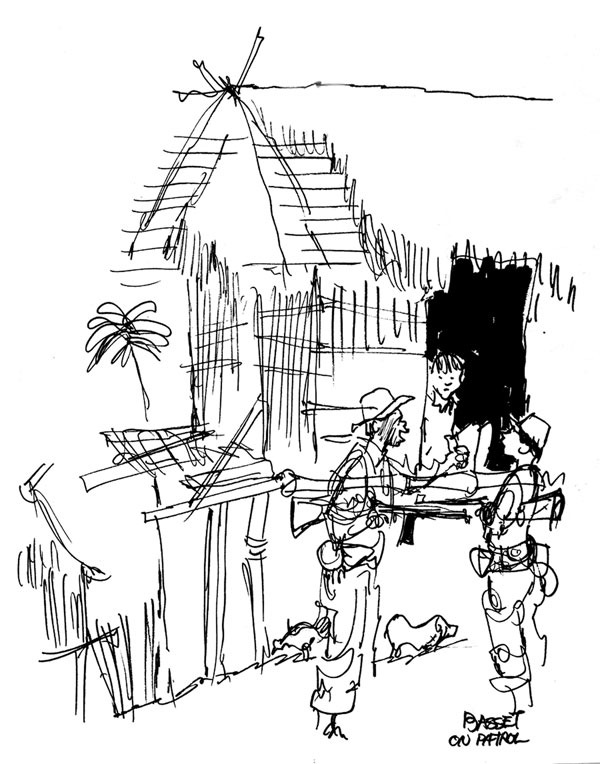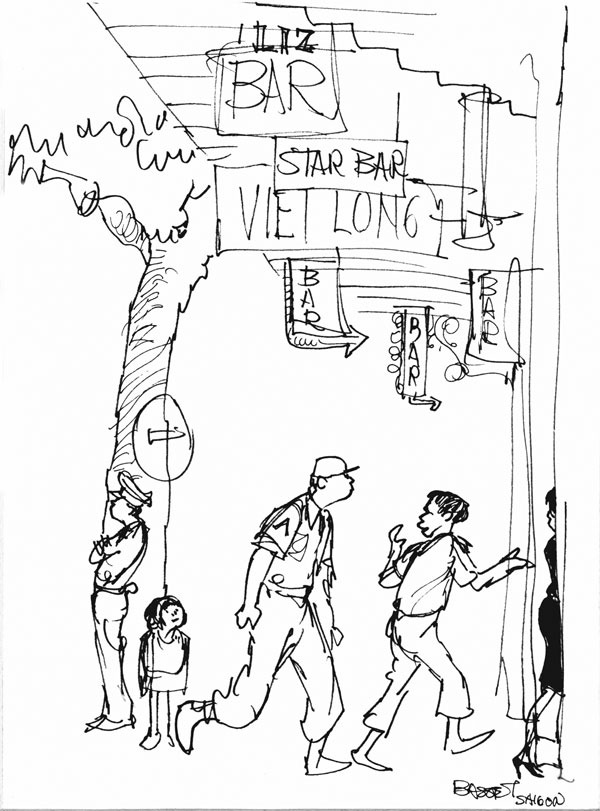

by Donald Myers ’83
In fall of 1965, acclaimed political cartoonist Gene Basset was sent by his employer, Scripps-Howard newspapers, to Vietnam to sketch first-hand the conflict, the Vietnamese people and their culture, and the effect of the fighting there. The Scripps-Howard papers were conservative and generally supported American involvement in Vietnam. Basset’s bosses hoped this trip would gain his support of the war, but it did not.
During his approximately three months in Vietnam, Basset witnessed and drew many impressive and often disturbing things. To mark the fortieth anniversary of his trip, Gustavus Adolphus College’s Hillstrom Museum of Art is featuring an exhibition of his drawings titled “Vietnam Drawings by Gene Basset.” The exhibition, supported by a generous grant from the Carl and Verna Schmidt Foundation, runs from February 14 through April 10, 2005, in conjunction with “Tales of Yellow Skin: The Art of Long Nguyen,” another exhibition of art relating to the Vietnam War.
Basset spent time aboard an aircraft carrier, on a coast guard cutter, on a patrol boat, and with soldiers on foot patrol, and the exhibition includes drawings relating to these and other experiences. He also made drawings in Saigon. One of these, exhibited as Nice Girl, shows an American soldier on a bar-lined commercial street being introduced to a prostitute, who leads him into a building for a tryst. This image was published on October 28, 1965, in The Cleveland Press, under the bowdlerized caption “Come, Real American Food.”
In addition to publishing many of his drawings, Basset also wrote an article that appeared in several newspapers across the nation in October 1965 recounting his time on foot patrol with Green Beret forces. The group was ambushed, and Basset narrowly escaped injury (one of his sketchbooks bears a bullet hole). Others in the company were not as fortunate, and Basset described the shooting of two soldiers on either side of him, one of whom died shortly afterwards. The artist related that the South Vietnamese soldiers, in retaliation, burned a village the Viet Cong had used as a base for the attack, a fire that resulted in the death of a handicapped child. One of exhibition’s drawings, Tell Him to Get Out Before We Torch the Place, is related to this incident and depicts a soldier warning of the danger while a villager lurks in the shadows of a thatched building behind. Nearby is a potbellied pig, an animal appearing in several of Basset’s Vietnam countryside views.
Basset’s drawing style is both economical and beautiful. With energetic and descriptive lines, and infrequent shading, he forms the figures and objects in his scenes. Basset’s manner is reminiscent of two of his artistic heroes, French political artist Honoré Daumier (1808—1879) and the Spaniard Francisco de Goya y Lucientes (1746—1828). The latter is particularly relevant in considering Basset’s Vietnam drawings, since Goya created “The Disasters of War” (1810—1814), a series of etchings showing brutality in wartime Spain under Napoleon’s invaders. Like Goya, Basset wished to convey, through his eyewitness images, his sense of the senselessness of war.
Basset’s illustrious career spanned several decades and his works appeared in national newspapers and on the covers of periodicals such as U. S. News and World Report. Born in Brooklyn in 1927, he studied art at Brooklyn College, the Cooper Union, the Art Students League, and the Pratt Institute. In the 1960s and ’70s, he was chief editorial cartoonist for the Scripps-Howard newspapers, publishers of several papers across the United States including the now-defunct Washington Daily News in Washington, D.C., where Basset lived. He moved to St. Peter in 1993 with his wife, Ann (Komatz ’51), following his retirement. He has since given a number of his original drawings to the College.
In conjunction with the Hillstrom Museum’s two Vietnam-related exhibitions, a lecture/discussion titled “The Vietnam War: History, Memory, and Representation” has been scheduled on the evening of March 7 at the museum. It will be led by Professor Greg Kaster, chair of the College’s Department of History, which has provided additional support for the exhibitions as well.
Donald Myers ’83 is director of the Hillstrom Museum of Art at Gustavus and an instructor of art history at the College.
Leave a Reply